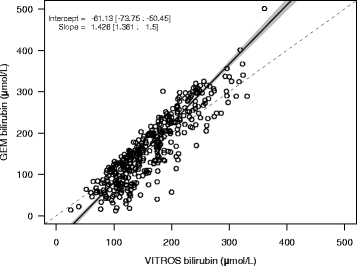Limitations and opportunities of whole blood bilirubin measurements by GEM premier 4000®
- PMID: 28356083
- PMCID: PMC5372304
- DOI: 10.1186/s12887-017-0842-8
Limitations and opportunities of whole blood bilirubin measurements by GEM premier 4000®
Abstract
Background: Neonatal hyperbilirubinemia has traditionally been screened by either total serum bilirubin or transcutaneous bilirubin. Whole blood bilirubin (TwB) by the GEM Premier 4000® blood gas analyzer (GEM) is a relatively new technology and it provides fast bilirubin results with a small sample volume and can measure co-oximetry and other analytes. Our clinical study was to evaluate the reliability of TwB measured by the GEM and identify analytical and clinical factors that may contribute to possible bias.
Methods: 440 consecutive healthy newborn samples that had plasma bilirubin ordered for neonatal hyperbilirubinemia screening were included. TwB was first measured using the GEM, after which the remainder of the blood was spun and plasma neonatal bilirubin was measured using the VITROS 5600® (VITROS).
Results: 62 samples (14%) were excluded from analysis due to failure in obtaining GEM results. Passing-Bablok regression suggested that the GEM results were negatively biased at low concentrations of bilirubin and positively biased at higher concentrations relative to the VITROS results (y = 1.43x-61.13). Bland-Altman plots showed an overall negative bias of the GEM bilirubin with a wide range of differences compared to VITROS. Both hemoglobin concentration and hemolysis affected the accuracy of the GEM results. Clinically, male infants had higher mean bilirubin levels, and infants delivered by caesarean section had lower hemoglobin levels. When comparing the number of results below the 40th percentile and above the 95th percentile cut-offs in the Bhutani nomogram which would trigger discharge or treatment, GEM bilirubin exhibited poor sensitivity and poor specificity in contrast to VITROS bilirubin.
Conclusions: An imperfect correlation was observed between whole blood bilirubin measured on the GEM4000® and plasma bilirubin on the VITROS 5600®. The contributors to the observed differences between the two instruments were specimen hemolysis and the accuracy of hemoglobin measurements, the latter of which affects the calculation of plasma-equivalent bilirubin. Additionally, the lack of standardization of total bilirubin calibration particularly in newborn specimens, may also account for some of the disagreement in results.
Keywords: Hyperbilirubinemia; Neonatal; Screening; Whole blood bilirubin.
Figures



Similar articles
-
Diagnostic methods for neonatal hyperbilirubinemia: benefits, limitations, requirements, and novel developments.Pediatr Res. 2021 Aug;90(2):277-283. doi: 10.1038/s41390-021-01546-y. Epub 2021 May 4. Pediatr Res. 2021. PMID: 33948000 Review.
-
Reliability of Total Bilirubin Measurements in Whole Blood from Preterm Neonates Using a Blood Gas Analyzer.Clin Lab. 2016 Nov 1;62(11):2285-2289. doi: 10.7754/Clin.Lab.2016.160419. Clin Lab. 2016. PMID: 28164678
-
Clinical implication of the difference between transcutaneous bilirubinometry and total serum bilirubin for the classification of newborns at risk of hyperbilirubinemia.Clin Biochem. 2009 Feb;42(3):176-9. doi: 10.1016/j.clinbiochem.2008.09.108. Epub 2008 Oct 2. Clin Biochem. 2009. PMID: 18929552 Clinical Trial.
-
Evaluation of the BiliChek noninvasive bilirubin analyzer for prediction of serum bilirubin and risk of hyperbilirubinemia.Am J Clin Pathol. 2008 Dec;130(6):976-82. doi: 10.1309/AJCPRX1E3NWCXHMZ. Am J Clin Pathol. 2008. PMID: 19019777
-
Screening methods for neonatal hyperbilirubinemia: benefits, limitations, requirements, and novel developments.Pediatr Res. 2021 Aug;90(2):272-276. doi: 10.1038/s41390-021-01543-1. Epub 2021 May 3. Pediatr Res. 2021. PMID: 33941863 Review.
Cited by
-
Point-of-Care Capillary Compared to Venous Bilirubin Measurement in Neonates.Indian J Clin Biochem. 2025 Jul;40(3):488-495. doi: 10.1007/s12291-024-01194-z. Epub 2024 Mar 10. Indian J Clin Biochem. 2025. PMID: 40620822 Free PMC article.
-
Neonatal hemoglobin affects the accuracy of whole blood bilirubin measurement on GEM Premier 4000 blood gas analyzers.Pract Lab Med. 2021 Apr 27;25:e00231. doi: 10.1016/j.plabm.2021.e00231. eCollection 2021 May. Pract Lab Med. 2021. PMID: 34095416 Free PMC article.
-
Accuracy and Reliability of Whole Blood Bilirubin Measurements Using a Roche Blood Gas Analyzer for Neonatal Hyperbilirubinemia Screening and Risk Stratification.Front Pediatr. 2022 Jul 4;10:910566. doi: 10.3389/fped.2022.910566. eCollection 2022. Front Pediatr. 2022. PMID: 35859945 Free PMC article.
-
Analytical performance validation and clinical application of blood gas analyzer on the detection of neonatal bilirubin.Transl Pediatr. 2021 Dec;10(12):3175-3183. doi: 10.21037/tp-21-541. Transl Pediatr. 2021. PMID: 35070831 Free PMC article.
-
Diagnostic methods for neonatal hyperbilirubinemia: benefits, limitations, requirements, and novel developments.Pediatr Res. 2021 Aug;90(2):277-283. doi: 10.1038/s41390-021-01546-y. Epub 2021 May 4. Pediatr Res. 2021. PMID: 33948000 Review.
References
-
- Raimondi F, Ferrara T, Borrelli AC, Schettino D, Parrella C, Capasso L. Neonatal hyperbilirubinemia: a critical appraisal of current guidelines and evidence. J Pediatr Neonatal individualized Med. 2012;1(1):25–32.
MeSH terms
Substances
LinkOut - more resources
Full Text Sources
Other Literature Sources
Medical
Research Materials

